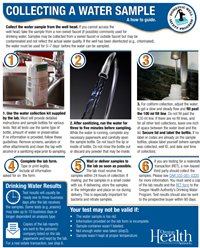Routine Domestic Well Testing
This page contains information on:
Requirements and recommendations
People in Oregon are only required to test their well water when
selling a property with a well. Visit the
Real Estate Transaction Page for more information on testing and reporting. If you are building a
new well,
other regulations apply.
Test well water regularly to protect your health!
Coliform and
E.coli bacteria | Every year | $20 to $40 | Diarrhea, cramps, nausea, headaches or other symptoms |
Nitrate
| Every year | $20 to $40 | Formula-fed babies are at risk for blue baby syndrome, a serious health condition that can be life-threatening. There is some evidence that drinking water with high levels of nitrate (10 miligrams per liter or more) can increase the risks of miscarriage and certain birth defects.
There is also weak and inconclusive evidence that long-term consumption of high amounts of nitrate may increase the risk of: - Thyroid issues
- Cancer of the stomach or bladder
|
| Arsenic | Every three to five years | $25 to $45 | Problems of skin, circulatory system nervous system, lungs, and bladder. These health problems include some forms of cancer. |
* You may wish to test for other contaminants
** You may need to test more frequently if:
- The well has a history of contamination
- Your septic system has recently malfunctioned
- Household members have a stomach illness
- Infants are drinking the water
- Any equipment has broken or malfunctioned
How to test well water
Take a water sample and send it to an accredited laboratory
-
If the water test is for a real estate transaction, samples must be collected according to Oregon Administrative Rule OAR 333-061-0335. Per OAR 333-061-0330, they must also be analyzed by an accredited laboratory.
- Use the water collection kit supplied by the laboratory. Most will provide detailed instructions. If they don't, refer to our collecting a water sample guidance.
- Get the sample to the lab as soon as possible, within 24 hours of collection.
- The sample must be taken correctly in order to show the most accurate results.
- Test results are usually ready 1 to 3 business days after the lab receives the samples. Some tests (like arsenic) may take up to 10 business days or longer dependent on analysis type.
What to do with test results
If bacteria or nitrate are present
This most likely means that surface contamination has found its way into the well and disease-causing organisms may be in your water. You may need to adjust the environment around your wellhead. You may also need to inspect your well system for damage or malfunctions. You may also install a treatment system.
If arsenic is present
If initial test results are above
8ppb, you should retest. If high concentrations continue; a treatment system should be installed.
Continue regular testing with a treatment system. Testing should be done:
- Every year at the faucet that you drink out of
and
-
Every 3 years at the wellhead
Resources
If the well water does not meet safety standards, more resources are available:
Reporting
-
If you are routinely testing your well, you
do not need to report your results.
- If you are selling your property, you will need to report test results to the Domestic Well Safety Program. Visit the
real estate transaction page for
more information on testing and reporting.